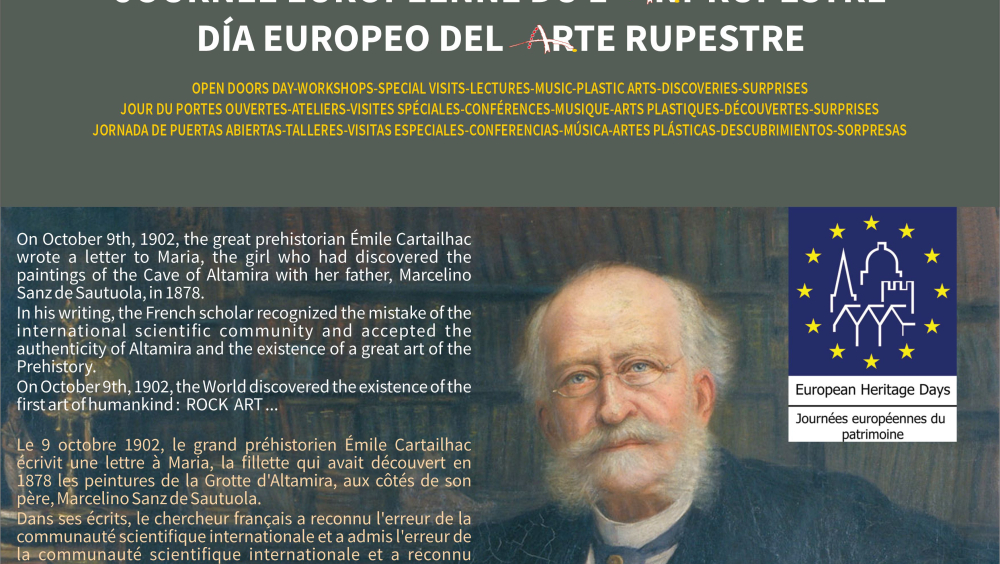9th October: European day of Prehistoric Rock Art
On October 9th, 1902, the great prehistorian Émile Cartailhac wrote a letter to Maria, the girl who had discovered the paintings of the Cave of Altamira with her father, Marcelino Sanz de Sautuola, in 1878. In his writing, the French scholar recognized the mistake of the international scientific community and accepted the authenticity of Altamira and the existence of a great art of the Prehistory. On October 9th, 1902, the World discovered the existence of the first art of humankind : ROCK ART ...
BACKGROUND: The European Association CAMINOS DE ARTE RUPESTRE PREHISTÓRICO (Prehistoric Rock Art Trails, www.prehistour.eu) has decided to promote the celebration of the European Day of Rock Art and present the proposal to the Council of Europe (CoE) and the European Commission, so that this event becomes part of the activities of the EUROPEAN HERITAGE DAYS. The day will be held in all sites belonging to the Cultural Route of the Prehistoric Rock Art Trails (https://www.coe.int/es/web/cultural-routes/prehistoric-rock-art-trails), on October 9, 2019. This date coincides with the 117th anniversary of the famous letter written by the prehistorian Emile Carthailac to the family of Marcelino Sanz de Sautuola, discoverer of the Altamira Cave. The letter, dated October 9 of 1902, expresses, for the first time, the official acceptance of the scientific community - through one of its highest authorities – of the intellectual capacities of prehistoric humans and the existence of the European prehistoric Rock Art. Prehistoric Rock Art is the art of the first Europeans. It appears in Europe about 42,000 years ago (perhaps earlier) and in some regions, lasts until historical periods. Since the scientific recognition of the Altamira cave, in 1902, prehistoric art has been an important cultural and touristic resource for Europe, since it is the first great cultural, social and symbolic expression of humanity. The importance of rock art sites in the member states of the Council of Europe has been recognized by UNESCO. Since 1976, different areas and sites have been classified as World Heritage Sites. Currently 11 rock art sites have this recognition in the 47 states of the Council of Europe. Today, more than 250 rock art sites are open to the public in member countries of the Council of Europe; 161 of them are part of one of the largest networks of archaeological sites: the Association Caminos de Arte Rupestre Prehistórico (Prehistoric Rock Art Trails). In 2010, this network was certified as a Cultural Route of the Council of Europe, due to its heritage values and the added interest of cooperation between institutions of 7 countries. OBJECTIVES: We intend to create this day to point out the cultural, artistic and touristic relevance and interest of prehistoric rock art and the danger these sites are facing today. In tune with the spirit of the EHD, the objectives are: To link EHD with the oldest and most extensive heritage in Europe. To promote full accessibility to European first art, implementing practices to include people with physical and sensorial disabilities in the knowledge of rock art, according to next EHD’s themes of Heritage and Education (2020) and Inclusive Heritage (2021). To strengthen pan-European cooperation with a large joint celebration of EHD in rural territories of Azerbaijan, France, Georgia, Italy, Norway, Portugal and Spain, that are part of the PRAT-CARP Itinerary. ACTIVITIES: October 9 will be an open doors day (or with discount) in all the locations of the Cultural Route of Rock Art of the CoE.. Visitors will be informed with leaflets and receive commemorative bracelets. We will promote that despite the changes experienced by Europe since Prehistory, rock art endures and unites us". We will organise information conferences, special visits, workshops for schoolchildren and facilitate accessibility for visually and hearing impaired people. There will be a pan-European drawing contest for schoolchildren (between 6 and 12 years old), with awards will consisting of books and teaching materials, as well as diplomas and free passes to visit rock sites of the cultural itinerary. The winning drawings will be part of traveling exhibition and a book called "The Art of Europe's past seen by Europeans of the future". BUDGET Each location assumes the expenses of the EHD of Rock Art activities. The dissemination on the web, social networks, media, schools and other stakeholders, as well as the promotional poster is assumed by the International PRAT-CARP Association. The traveling exhibition and the production of the book "The Art of the past of Europe seen by the Europeans of the future" will need financing by the cross frontier contest, to count with a permanent resource. PARTICIPANTS A total of 118 locations (museums, interpretation centers, rock sites) from 7 countries will take part in this initiative. The program of each site for the European Day of Rock Art (October 9) is already under preparation.
The first Art of the Europeans, prehistoric rock art, is the first great artistic and cultural manifestation of our specie in Europe. It was discovered on 1878 by Marcelino Sanz de Sautuola and his daughter Maria in the cave of altamira (Cantabria, Spain), but it didn't be recognized until 1902, when other caves with paintings were discovered in France. The story of contempt and incomprehension that Sautuola's family suffered was similar than the case of Charles Darwin. In 1902, all the scientific community, leaded by the great prehistorian Emile Cartailhac, had to recognize the value and the importance of the first art of Europe (the first art of the World), preserved in the caves of Spain and France (but in other countries too). Today, 7 countries of the Council of Europe with plenty of sites with Prehistoric Rock Art want to celebrate together the first cultural and artistic manifestation of the European people, remembering the role of Sautola and Maria (his daughter) in the discovery of the Prehistoric Rock Art.
